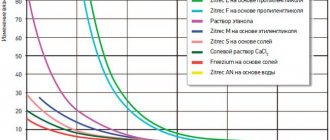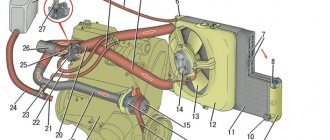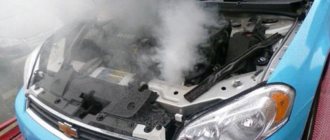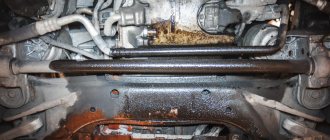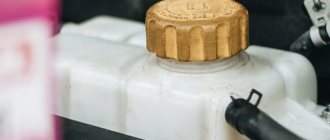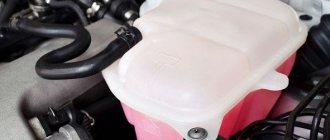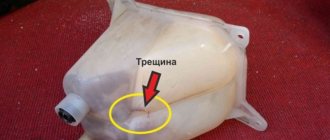Coolant (antifreeze or antifreeze) is an integral consumable item for every car.
Refrigerants of red, blue, green and other colors differ in composition and set of additives. However, not all antifreezes retain their original color throughout their entire service life.
A common situation is when, just a few days after filling, the coolant darkens, boils and foams, which causes serious trouble for the driver.
In this article we will answer the question “Why did the antifreeze turn rusty?” Let's look at what causes this problem and how to avoid it.
There are several nuances that will help increase the resource of “Antifreeze” or antifreeze:
- The first thing to remember is that the consumables should always be of the highest quality. If you do not want to face the problem of darkened Antifreeze, then you cannot use liquid purchased from merchants on the side of the road or in unverified stores. If you are using original products, pay attention to checking the place of production. Sometimes high-quality European antifreezes are made in China or Mongolia, which, of course, indicates their poor quality.
- The performance characteristics of the fluid should also be given attention. You should know which specific antifreeze your car manufacturer recommends using. There are certain additives, the use of which is permitted or not permitted by the machine manufacturer. Therefore, such nuances should be taken into account.
- The cooling system should always be flushed before replacing consumables. Regardless of whether obvious deposits are visible in the expansion tank or not. Flushing will always help get rid of sediments that may not be visible to the naked eye. In any case, even after a year of operation of the coolant, there will be deposits in the system pipes, let alone three to four years of using the refrigerant.
Recommendations from car manufacturers for replacing coolant
There are no general recommendations from car manufacturers on the topic “How often should you change antifreeze in a car”; each company approaches this issue purely individually, depending on its own developments. For example, Volkswagen, General Motors, Mazda, Renault, after the cars leave the production line and the cooling system is factory filled with antifreeze, generally recommend not changing the coolant, setting a lifetime service life for it. The German Ford sets periods for replacing antifreeze in its cars every 10 years or after 240 thousand kilometers. "Mercedes" - 5 years. "BMW" and "Mitsubishi" - 4 years. VAZ determines the period for replacing antifreeze with a mileage of 75 thousand km for its models.
Moreover, in the future it is recommended to change the antifreeze to the same one that was originally poured into the car at the factory. If for some reason it is impossible to determine the original brand of coolant, then it is better to fill in G12 class antifreeze, which is considered the most universal, without forgetting to first flush the cooling system.
Why did the antifreeze quickly darken after replacement?
You need to figure out whether there are contaminants in the cooling system. Since the refrigerant can quickly darken due to the fact that the cooling system has not been flushed. Impurities and deposits remain inside the channels and hoses, which end up in the recently filled antifreeze, which circulates in a circle.
Therefore, during a scheduled fluid change, it is necessary to drain the old Antifreeze and add water or the compositions described above to the radiator. Having cleaned the system in this way and gotten rid of the dirty substance, you can safely refill the car with new antifreeze. It is highly not recommended to simply add refrigerant to the unit.
Replaced it after a couple of weeks, dark again
This also happens, it seems like I drained the old fluid and poured in a new clean one, but a couple of weeks passed and it’s dark again. WHY? YES it's simple. You didn't flush the system, THIS IS A GREAT MISTAKE!
When the antifreeze is new, it begins to wash away all the old plaque from the walls and pipes inside. It is because of this that even new liquid will quickly turn back into brown.
Therefore, we remember - be sure to rinse.
Now we are watching the video version.
I’ll end here, I think my article and video were useful to you. Sincerely yours, AUTOBLOGGER.
Similar news
- How to choose anti-freeze for a car? Cheap and odorless
- DIY WD-40. How to make an almost complete analogue
- Antifreeze (antifreeze) into the washer reservoir. Filled, what should I do?
Add a comment Cancel reply
Why did antifreeze turn brown?
If the color of the antifreeze has changed, it usually means one thing: the coolant has lost its properties. First, the antifreeze becomes greenish, then yellow and finally colorless. Thus, the loss of color for antifreeze is characterized, first of all, by the fact that the liquid gradually becomes unusable. The unsuitability lies in the development of corrosion inhibitors that interfere with the normal operation of the car. The speed at which antifreeze changes its color indicates the following:
- If the antifreeze turns yellow after about five hundred hours of operation, then there is a fact of incorrect engine operation, that is, the engine is overheating - above 105 degrees
- If the antifreeze turns green during the same five hundred hours of operation, then the engine runs without overheating
But antifreeze can turn black, brown, and red. There are several explanations for the change in color of the coolant during vehicle operation:
- Antifreeze has lost its properties
- There may be a breakdown of the radiator with the stove or the formation of a corrosion process of the radiator
- A corrosion process has occurred in the engine system
Here are the main reasons why antifreeze turned black or brown.
How to recognize a cooling system malfunction
The most common malfunction of the cooling system is a leak of antifreeze - a coolant that increases engine efficiency and protects it from overheating. Antifreeze also allows you to save on fuel.
A car engine operates most productively in a certain temperature range. When the engine temperature begins to exceed its permissible value, you may observe the following symptoms:
- a plume of steam is pouring out from under the hood;
- White smoke is visible from the muffler;
- the stove in the cabin begins to cool the air rather than warm it up;
- the dashboard received a signal about engine overheating;
- The thermometer needle has reached its maximum value.
Antifreeze is leaking
Several signs may appear at once, or maybe just one, but in any case, you should immediately turn off the car’s ignition.
Main reasons
It should be noted that antifreeze, like oil, has a certain shelf life. Often replacement is required every 50,000 km, but the figure is average and depends on the quality of the fluid and the manufacturer.
There are several main factors why antifreeze turns rusty in color. The main ones are:
- The expiration date has expired. A brown tint indicates that the additives in the material can no longer perform their intended functions and precipitation begins, which causes a color change.
- Motor overheating. The problem may lie in untimely change of fluid, and after the end of its service life it quickly boils and the original shade changes. In addition, overheating of the motor can be due to many other reasons, which also cause a rusty color.
- Oxidation of parts. The cooling system contains metal structures that can rust and change the color of the antifreeze. The problem is typical for long-term use of a liquid that can no longer protect the metal surface. The natural oxidation process begins.
- Destruction of pipes. Without a scheduled replacement of the coolant, it causes rubber products, namely pipes, to become unusable; they are gradually destroyed, and their parts end up in the liquid itself, but the color will often be black, not red.
- Water instead of antifreeze. During leaks, many people use water as a temporary alternative. Such measures should be used in extreme cases, and after water it is important to thoroughly rinse the system and add antifreeze. If you do not follow the rule, then metal parts will rust from water and in the future change the color of the coolant.
- Oil ingress. If the gaskets break, oil from the engine can enter the cooling system and change color during mixing. In this case, the antifreeze will not only be rusty, but an emulsion will appear in the tank, which resembles condensed milk in color and consistency.
- Use of chemistry. Radiator leaks often appear while driving; in emergency situations, leak removal additives, sealants, and other chemicals can be used. They help for a short time, and the antifreeze itself quickly turns brown.
Understanding what the reason is, it is necessary to eliminate it and replace the fluid with a new one. Leaving the process to chance is fraught with consequences. The main danger is engine overheating, which causes serious and expensive repairs.
We recommend: What is the normal thermal clearance for piston rings?
In some cases, even after changing the antifreeze, it may turn red after a couple of weeks. The problem arises due to non-compliance with basic rules. Namely, that after removing the main cause, the system must be flushed, otherwise the antifreeze will quickly turn red and its properties will be lost. The new fluid in the system begins to wash away the old plaque, gradually becoming colored.
Methods for solving the problem
To solve the problem with rusty antifreeze, the car enthusiast needs to know the exact cause. If an emulsion or parts of engine oil appear under the expansion tank cap, then you need to look for the fault as quickly as possible. It is recommended to pay attention to:
- Cylinder head gasket.
- Heat exchanger.
- Pipes and other types of gaskets.
As a rule, in the first two places there is often contact between oil and coolant. After combining the liquids, the cooling system begins to become clogged and the engine malfunctions. After removing the cause, the systems are flushed and the coolant is replaced.
It is much easier to solve the problem if the antifreeze has expired. It will be enough to replace the liquid, but first rinse everything with special products or distilled water. Rinsing is carried out until the water is clear, without a red tint.
Causes
This is what waste that has lost its color looks like
In fact, there are not many reasons why “Tosol” turned brown.
Let's look at them all in order:
- The first and most common reason is that “Antifreeze” has lost its performance properties. In other words, antifreeze is no longer able to perform the functions assigned to it. Typically, this problem occurs as a result of using coolant for a long time without replacing it. As the chemicals present in the refrigerant lose their properties, this will somehow affect the color of the liquid. Accordingly, a change in its color may signal the driver about the need to replace consumables.
- Another of the most likely reasons is a large amount of deposits in the system. When replacing consumables in the cooling system, the entire system must be flushed. If the system is not flushed, then all the deposits that accumulated during operation of the vehicle with old antifreeze will remain in the pipes. Accordingly, when new Antifreeze is poured in, it can almost immediately turn brown as soon as the consumable material passes through all the hoses of the cooling system. This is the answer to the question of many car owners: “Why did I just change the antifreeze, but it turned brown?” Believe me, motorists ask themselves this question very often, although the answer to it lies on the surface.
- Metal corrosion or rubber destruction. The fact is that today many antifreezes contain all kinds of inhibitors and other chemical elements that perform various functions. These additives are designed to prevent corrosion, the appearance of foam in the system, increase the service life of the fluid, and many others. If you often mix one brand of Antifreeze with another, then you shouldn’t be surprised why it turned brown. As a rule, as a result of mixing, the coolant loses its properties, which primarily affects the anti-corrosion characteristics of the consumable material. Accordingly, rust begins to form almost immediately, which, of course, immediately affects the color of the “Antifreeze”. If it turns brown, then most likely it has lost its properties, and the internal components of the cooling system have become rusty. Actually, for the same reason, the rubber components of the system are destroyed. Many antifreezes today contain elements that prevent the destruction of the rubber pipes of the system. If the refrigerants being filled are incompatible, these substances lose their functions, which provokes the destruction of rubber parts.
- Another reason could be a blown cylinder head gasket. When the gasket shows signs of damage, coolant will leak into the engine. On the contrary, engine oil will flow into the cooling system. As you understand, in this case you shouldn’t wonder why “Tosol” turned brown. After all, when mixing coolant with motor fluid, a change in color is not the worst thing that can happen. As a rule, in such cases, the consumable material begins to bubble in the expansion tank, and its color becomes very dark.
We recommend: Replacing the fog lamp on a Lada Priora (VAZ Priora)
Class G12
How to change the color of a car in PTS
What can you say about the G12? How often should I change this antifreeze? The answer to this question depends on how the replacement was carried out. If the car's cooling system was previously washed and dried, the service life of the new antifreeze will be 5 years. If the system was not flushed or fluid was added during operation, the service life is reduced to 3 years.
The service life of class G12 antifreezes has been increased due to the fact that they contain additives based on carboxylic acids that act directly on the source of corrosion, without forming a protective layer.
In G12+ antifreeze, inorganic additives were added to the existing additives, and in G12++, mineral additives were added. All these additives improved the protection of the cooling system, but did not affect the replacement period.
Causes of changes in color and odor of liquid
Experienced motorists know that over time, inside the expansion tank, instead of the usual shades, you can see an incomprehensible dark liquid. The process of refrigerant changing color is not normal.
In most cases, Antifreeze acquires a brown tint or completely black; in rare cases, it foams, darkens, and sometimes comes with flakes. And often this happens about 2-3 weeks after the fluid change.
Any darkening of the antifreeze indicates important problems that cannot be ignored. It is likely that the antifreeze has expired. This can be determined by the color transformation. First it changes from blue to green, then to transparent. Or it turns yellow and then completely colorless. Thus, the loss of the initial color indicates that the liquid is unsuitable for further use. At the same time, the refrigerant acquires a strong and unpleasant odor.
But often the problem is caused by the following reasons:
- The surfaces of metal components and parts that the liquid washes have oxidized. This is a common problem in used cars. Rust appears on them, it gets into the antifreeze circulating throughout the system. This changes the color.
- Low-quality antifreeze was poured into the expansion tank, without restraining additives. As you know, an overly aggressive liquid easily eats through rubber materials: hoses, pipes, gaskets. In this case, the refrigerant will be black.
- Instead of antifreeze, ordinary water is often used. This happens, for example, on the road, when there is no coolant at hand and one of the pipes breaks. You have to fill it with tap water, which over time will form scale on the walls of the radiator.
- Antifreeze has lost its properties and changed color. Its protective additives have stopped working and the fluid is no longer able to withstand high temperatures. Already at 90°C foam can form.
- Engine oil has gotten into the coolant. This happens for various reasons, usually the cylinder head gasket is drying out.
- Adding chemicals to the radiator. Some motorists believe in miracle additives that supposedly quickly eliminate leaks in the radiator. In fact, there is no benefit from them, but the color of the refrigerant changes greatly, as it reacts with these substances.
- The antifreeze was replaced, but the system was not flushed for a long time. Sediment has accumulated. When new fluid is poured in, all contaminants are mixed with it, and the antifreeze turns black or becomes cloudy in color.
- The cooling system or oil heat exchanger, which is installed on many modern cars with powerful engines, is faulty. Especially if the antifreeze has turned black.
We recommend: What to do if the fan of the VAZ-2112 stove does not work
It is noteworthy that in some cases antifreeze turns red. This happens over time, and the cause is the reaction of the engine subjected to excessive loads. For example, if the car is often stuck in traffic jams or the driver’s driving style does not comply with the rules, then the coolant quickly loses its properties. In addition, the red color indicates the presence of corrosion on the system elements.
What to do?
If the color of antifreeze changes, it is simply necessary to eliminate the problem as soon as possible. This is especially important when an oil emulsion appears in the system. In this case, the engine must not be started until the fault is eliminated. Usually the cause is a blown engine head gasket.
If rust appears, you should simply replace the antifreeze. But, before filling in new coolant, it is necessary to flush the system, otherwise the problem will recur.
Problems with the cooling system are not uncommon. In this regard, the question of why antifreeze (antifreeze) turned rusty or brown is not rare enough. This deficiency occurs quite often, so you need to know how to eliminate it.
The coolant consists of water, antifreeze, special additives (corrosion inhibitors) that protect the cooling system of the internal combustion engine from corrosion processes and the liquid itself from thermochemical destruction, and lubricants for the cooling system pump (pump).
Antifreeze is a compound that, when mixed with water, lowers the freezing point of the mixture. Antifreezes are almost all aqueous solutions of inorganic salts (sodium chloride, potassium, calcium), aniline, alcohols, glycerin, glycols, cellosolves, carbitols, etc. Currently, ethylene glycol-based coolants are mainly used.
Ethylene glycol is diluted with water in the following proportions (ethylene glycol: water) 1:1, 2:3, or 1:2. Propylene glycol antifreezes are less toxic, but they are more expensive to produce and have a lower boiling point. All ethylene glycol coolants differ in quality from each other only in the set (or absence) of the necessary additives and the degree of dilution with water.
Glycol-based coolants are highly toxic if ingested. Because they taste sweet, children and pets are most at risk of poisoning. In the USA, for example, several states have required manufacturers to add bitter flavoring additives to antifreeze.
In case of poisoning, glycol antifreeze affects the central nervous system, causing loss of coordination, weakness, and vomiting. One of the best antifreezes is 40° ethyl alcohol, which has not become widespread in this capacity, since drivers mainly take it internally. Antifreeze[edit]
“Tosol” is a trade designation for non-freezing coolant developed in the USSR, although nowadays “Tosol” is often called any coolant. Ethylene glycol is used as antifreeze in Antifreeze. TOSOL is designed to cool car engines at any time of the year within the temperatures specified in the brands.
The numbers 40 and 65 in Tosol stamps indicate the beginning of the freezing temperature of the stamp. The lowest freezing point of the ethylene glycol-water system is about −70 °C. Externally, standard TOSOL-40 is a blue liquid, TOSOL-65 is red. Color is necessary to clearly determine the level of coolant in the expansion tank, so as not to confuse different brands, and also to distinguish smudges of coolant from smudges of other operating fluids; a change in the color of the coolant during operation signals the loss of operational properties of the coolant and its necessary replacement.
Choosing quality antifreeze
When choosing a coolant, it would be correct to focus not on the shade, but on the composition of the mixture and the brand’s reputation. Choose high-quality mixtures that are protected from counterfeiting and suitable for your car. SINTEC Multifreeze is the optimal solution, universal and suitable for different types of loads and engines. Multifreeze combines the advantages of both types of coolant, as it contains both inorganic additives and carboxylic acids. Can be used for a long time and does not turn brown. Its innovative properties make it possible to operate for a long time without deteriorating.
#Trouble-shooting
